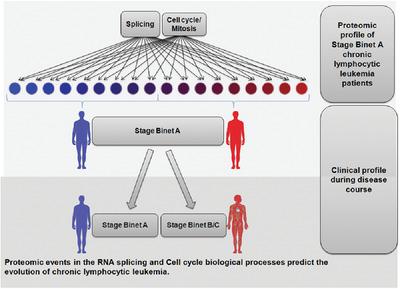当前位置:
X-MOL 学术
›
J. Leukoc. Biol.
›
论文详情
Our official English website, www.x-mol.net, welcomes your
feedback! (Note: you will need to create a separate account there.)
Identification of altered cell signaling pathways using proteomic profiling in stable and progressive chronic lymphocytic leukemia
Journal of Leukocyte Biology ( IF 3.6 ) Pub Date : 2021-07-20 , DOI: 10.1002/jlb.4hi0620-392r Cristina Bagacean 1, 2 , Cristina Adela Iuga 3, 4 , Anne Bordron 1 , Adrian Tempescul 1, 2 , Ioana-Ecaterina Pralea 4 , Delphine Bernard 5 , Melanie Cornen 1 , Tiffany Bergot 5 , Christelle Le Dantec 1 , Wesley Brooks 6 , Hussam Saad 2 , Jean-Christophe Ianotto 2 , Jacques-Olivier Pers 1 , Mihnea Zdrenghea 7 , Christian Berthou 1, 2 , Yves Renaudineau 1, 8
Journal of Leukocyte Biology ( IF 3.6 ) Pub Date : 2021-07-20 , DOI: 10.1002/jlb.4hi0620-392r Cristina Bagacean 1, 2 , Cristina Adela Iuga 3, 4 , Anne Bordron 1 , Adrian Tempescul 1, 2 , Ioana-Ecaterina Pralea 4 , Delphine Bernard 5 , Melanie Cornen 1 , Tiffany Bergot 5 , Christelle Le Dantec 1 , Wesley Brooks 6 , Hussam Saad 2 , Jean-Christophe Ianotto 2 , Jacques-Olivier Pers 1 , Mihnea Zdrenghea 7 , Christian Berthou 1, 2 , Yves Renaudineau 1, 8
Affiliation

|
Chronic lymphocytic leukemia (CLL) is characterized by significant biologic and clinical heterogeneity. This study was designed to explore CLL B-cells’ proteomic profile in order to identify biologic processes affected at an early stage and during disease evolution as stable or progressive. Purified B cells from 11 untreated CLL patients were tested at two time points by liquid chromatography–tandem mass spectrometry. Patients included in the study evolved to either progressive (n = 6) or stable disease (n = 5). First, at an early stage of the disease (Binet stage A), based on the relative abundance levels of 389 differentially expressed proteins (DEPs), samples were separated into stable and progressive clusters with the main differentiating factor being the RNA splicing pathway. Next, in order to test how the DEPs affect RNA splicing, a RNA-Seq study was conducted showing 4217 differentially spliced genes between the two clusters. Distinct longitudinal evolutions were observed with predominantly proteomic modifications in the stable CLL group and spliced genes in the progressive CLL group. Splicing events were shown to be six times more frequent in the progressive CLL group. The main aberrant biologic processes controlled by DEPs and spliced genes in the progressive group were cytoskeletal organization, Wnt/β-catenin signaling, and mitochondrial and inositol phosphate metabolism with a downstream impact on CLL B-cell survival and migration. This study suggests that proteomic profiles at the early stage of CLL can discriminate progressive from stable disease and that RNA splicing dysregulation underlies CLL evolution, which opens new perspectives in terms of biomarkers and therapy.
中文翻译:

在稳定和进行性慢性淋巴细胞白血病中使用蛋白质组学分析识别改变的细胞信号通路
慢性淋巴细胞白血病 (CLL) 的特点是显着的生物学和临床异质性。本研究旨在探索 CLL B 细胞的蛋白质组学特征,以确定在早期阶段和疾病演变过程中受影响的生物过程是稳定的还是进行性的。通过液相色谱-串联质谱法在两个时间点对来自 11 名未治疗 CLL 患者的纯化 B 细胞进行了测试。纳入研究的患者演变为进展性(n = 6)或稳定疾病(n = 5)。首先,在疾病的早期阶段(Binet 阶段 A),基于 389 种差异表达蛋白 (DEP) 的相对丰度水平,样本被分成稳定和渐进的簇,主要区分因素是 RNA 剪接途径。接下来,为了测试 DEP 如何影响 RNA 剪接,进行了一项 RNA-Seq 研究,显示两个簇之间有 4217 个差异剪接基因。在稳定的 CLL 组中观察到明显的纵向进化,主要是蛋白质组修饰,在进行性 CLL 组中观察到剪接基因。在进行性 CLL 组中,剪接事件的发生频率高出 6 倍。在进行性组中由 DEPs 和剪接基因控制的主要异常生物学过程是细胞骨架组织、Wnt/β-连环蛋白信号、线粒体和磷酸肌醇代谢对 CLL B 细胞存活和迁移有下游影响。这项研究表明,CLL 早期的蛋白质组学特征可以区分进展性疾病和稳定疾病,并且 RNA 剪接失调是 CLL 进化的基础,这为生物标志物和治疗开辟了新的视角。
更新日期:2021-07-20
中文翻译:

在稳定和进行性慢性淋巴细胞白血病中使用蛋白质组学分析识别改变的细胞信号通路
慢性淋巴细胞白血病 (CLL) 的特点是显着的生物学和临床异质性。本研究旨在探索 CLL B 细胞的蛋白质组学特征,以确定在早期阶段和疾病演变过程中受影响的生物过程是稳定的还是进行性的。通过液相色谱-串联质谱法在两个时间点对来自 11 名未治疗 CLL 患者的纯化 B 细胞进行了测试。纳入研究的患者演变为进展性(n = 6)或稳定疾病(n = 5)。首先,在疾病的早期阶段(Binet 阶段 A),基于 389 种差异表达蛋白 (DEP) 的相对丰度水平,样本被分成稳定和渐进的簇,主要区分因素是 RNA 剪接途径。接下来,为了测试 DEP 如何影响 RNA 剪接,进行了一项 RNA-Seq 研究,显示两个簇之间有 4217 个差异剪接基因。在稳定的 CLL 组中观察到明显的纵向进化,主要是蛋白质组修饰,在进行性 CLL 组中观察到剪接基因。在进行性 CLL 组中,剪接事件的发生频率高出 6 倍。在进行性组中由 DEPs 和剪接基因控制的主要异常生物学过程是细胞骨架组织、Wnt/β-连环蛋白信号、线粒体和磷酸肌醇代谢对 CLL B 细胞存活和迁移有下游影响。这项研究表明,CLL 早期的蛋白质组学特征可以区分进展性疾病和稳定疾病,并且 RNA 剪接失调是 CLL 进化的基础,这为生物标志物和治疗开辟了新的视角。











































 京公网安备 11010802027423号
京公网安备 11010802027423号